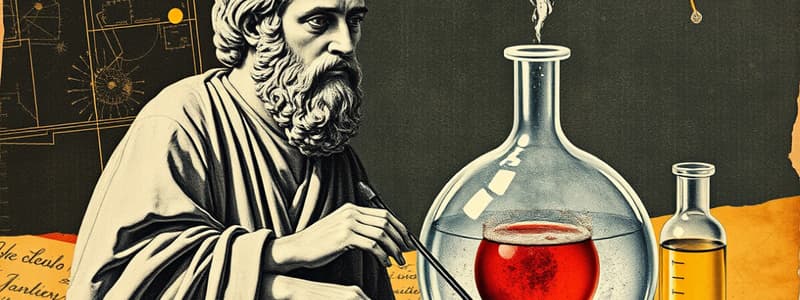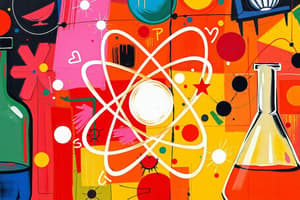Podcast
Questions and Answers
This theory was ignored and forgotten for more than ______ years.
This theory was ignored and forgotten for more than ______ years.
2000
Aristotle and Plato favored the earth, fire, water, and air approach to the nature of ______.
Aristotle and Plato favored the earth, fire, water, and air approach to the nature of ______.
matter
The element representing fire corresponds to the qualities of ______ and dry.
The element representing fire corresponds to the qualities of ______ and dry.
hot
The element of water is represented by a ______ triangle.
The element of water is represented by a ______ triangle.
According to Aristotle, earth is associated with the qualities of cold and ______.
According to Aristotle, earth is associated with the qualities of cold and ______.
Democritus proposed an Atomic Theory which states that all atoms are small, hard, ______ and indestructible particles.
Democritus proposed an Atomic Theory which states that all atoms are small, hard, ______ and indestructible particles.
Democritus believed that matter could be divided until it reached the smallest piece called an ______, meaning "not to be cut".
Democritus believed that matter could be divided until it reached the smallest piece called an ______, meaning "not to be cut".
Democritus stated that atoms are infinite in number, always ______ and capable of joining together.
Democritus stated that atoms are infinite in number, always ______ and capable of joining together.
According to Democritus, the properties of matter are determined by the ______ of the atoms.
According to Democritus, the properties of matter are determined by the ______ of the atoms.
Aristotle did not support Democritus's ______ theory.
Aristotle did not support Democritus's ______ theory.
Antoine Lavoisier is known as the 'Father of Modern _____.'
Antoine Lavoisier is known as the 'Father of Modern _____.'
John Dalton proposed an Atomic Theory which states that all substances are made of _____; atoms are small particles that cannot be created, divided, or destroyed.
John Dalton proposed an Atomic Theory which states that all substances are made of _____; atoms are small particles that cannot be created, divided, or destroyed.
Lavoisier discovered the Law of Conservation of Mass, which states that in a chemical reaction, matter is neither created nor _____ .
Lavoisier discovered the Law of Conservation of Mass, which states that in a chemical reaction, matter is neither created nor _____ .
Dalton calculated the _____ weights of many various elements.
Dalton calculated the _____ weights of many various elements.
Atoms of different elements are _____ .
Atoms of different elements are _____ .
Ernest Rutherford is known as the 'Father of ______ Physics'.
Ernest Rutherford is known as the 'Father of ______ Physics'.
In 1909, Rutherford performed the ______ Experiment.
In 1909, Rutherford performed the ______ Experiment.
The nucleus of the atom contains positively charged particles called ______.
The nucleus of the atom contains positively charged particles called ______.
Rutherford’s experiment showed that most of the atom is actually ______ space.
Rutherford’s experiment showed that most of the atom is actually ______ space.
Rutherford was a student of ______ Thomson.
Rutherford was a student of ______ Thomson.
Rutherford concluded that an atom had a small, dense, positively charged center called the ______.
Rutherford concluded that an atom had a small, dense, positively charged center called the ______.
In Rutherford's experiment, the expected result was that alpha particles should pass through the gold foil with minor ______.
In Rutherford's experiment, the expected result was that alpha particles should pass through the gold foil with minor ______.
Rutherford reasoned that all of an atom's positively charged particles were contained in the nucleus, while negatively charged particles were scattered outside the nucleus around the ______.
Rutherford reasoned that all of an atom's positively charged particles were contained in the nucleus, while negatively charged particles were scattered outside the nucleus around the ______.
In the experiment, most alpha particles passed straight through, but some were deflected at large angles and some ______ back.
In the experiment, most alpha particles passed straight through, but some were deflected at large angles and some ______ back.
The positively charged center of the atom that repelled Rutherford's positively charged 'bullets' is known as the ______.
The positively charged center of the atom that repelled Rutherford's positively charged 'bullets' is known as the ______.
J.J. Thomson discovered ______, which were later called electrons.
J.J. Thomson discovered ______, which were later called electrons.
In 1897, Thomson proposed the ______ Model.
In 1897, Thomson proposed the ______ Model.
Thomson concluded that the negative charges come from within the ______.
Thomson concluded that the negative charges come from within the ______.
Thomson stated that an atom is ______.
Thomson stated that an atom is ______.
Thomson studied the passage of an electric current through a ______.
Thomson studied the passage of an electric current through a ______.
The probable location of an electron is based on how much ______ the electron has.
The probable location of an electron is based on how much ______ the electron has.
An atom has a small positively charged nucleus surrounded by a large region in which there are enough electrons to make an atom ______.
An atom has a small positively charged nucleus surrounded by a large region in which there are enough electrons to make an atom ______.
Electrons whirl about the nucleus a billion of times in one ______.
Electrons whirl about the nucleus a billion of times in one ______.
James Chadwick discovered the ______ in 1932.
James Chadwick discovered the ______ in 1932.
James Chadwick worked on the ______ Project.
James Chadwick worked on the ______ Project.
In 1913, Niels Bohr proposed the ______ Model.
In 1913, Niels Bohr proposed the ______ Model.
According to Bohr's atomic model, electrons travel in ______ around the nucleus.
According to Bohr's atomic model, electrons travel in ______ around the nucleus.
Erwin Schrodinger introduced the concept of ______ clouds to describe where electrons may be found.
Erwin Schrodinger introduced the concept of ______ clouds to describe where electrons may be found.
Schrodinger developed a mathematical framework known as the ______ equation.
Schrodinger developed a mathematical framework known as the ______ equation.
Both Niels Bohr and Erwin Schrodinger were awarded a ______ Prize for their contributions to physics.
Both Niels Bohr and Erwin Schrodinger were awarded a ______ Prize for their contributions to physics.
Study Notes
Democritus
- Developed atomic theory in collaboration with Leucippus, proposing atoms as indivisible and indestructible units of various shapes and sizes.
- Introduced the concept of "atoms" meaning "not to be cut," suggesting a limit to matter division.
- Atoms are infinitely numerous, perpetually in motion, and capable of combining to form different substances.
- The Greek understanding of atoms influenced interpretations of properties: for instance, water has smaller, closely packed atoms, while iron features larger atoms.
Ignorance of Democritus' Theory
- The atomic theory was neglected for over 2000 years largely due to the dominance of Aristotle and Plato's elements theory.
- Aristotle favored the view of matter consisting solely of earth, fire, water, and air, overshadowing atomic ideas.
- Visual representation of elements in Aristotle's theory categorized them by temperature and moisture combinations.
Antoine Lavoisier
- Renowned as the "Father of Modern Chemistry."
- Created a list of thirty-three elements that established a foundational framework in chemistry.
- Introduced the metric system for standardized measurements.
- Married Marie-Anne Pierette Paulze, who significantly collaborated on his research.
- Executed during the French Revolution as a tax-collector.
- Discovered the role of oxygen in combustion and formulated the Law of Conservation of Mass, which states matter is neither created nor destroyed during chemical reactions.
John Dalton
- Proposed an atomic theory in 1803 asserting all matter comprises indivisible atoms unique to each element.
- Established that atoms combine to form new substances.
- Calculated atomic weights of numerous elements.
- Indicated that atoms of the same element are identical while those of different elements vary.
- Noted for being a teacher at an early age and for his color blindness.
J.J. Thomson
- Demonstrated that atoms could be divided into smaller constituents.
- Discovered electrons (initially termed corpuscles) through cathode-ray tube experiments.
- Proposed the Plum Pudding Model, describing atoms as positive material with embedded negative electrons.
- Awarded a Nobel Prize for his contributions.
Ernest Rutherford
- Conducted the Gold Foil Experiment in 1909, leading to major insights into atomic structure.
- Identified the nucleus as a dense core containing protons, surrounded by mostly empty space with negative electrons.
- Concluded that the atom is not solid but composed of a tiny nucleus repelling positive charges.
- Received a Nobel Prize and is known as the "Father of Nuclear Physics."
Niels Bohr
- Introduced the Bohr Model in 1913, suggesting electrons orbit the nucleus in defined paths or energy levels.
- Demonstrated that electrons can transition between energy levels based on their energy state.
- Received a Nobel Prize for his work in atomic structure, collaborating with Rutherford.
Erwin Schrödinger
- In 1926, expanded on atomic theory by introducing the concept of electron clouds, indicating the probable locations of electrons based on energy levels.
- Developed the Schrödinger equation, formalizing wave mechanics in quantum theory.
- Awarded a Nobel Prize in recognition of his contributions.
James Chadwick
- Identified the neutron in 1932, explaining the atomic mass discrepancies that correspond to double the number of protons.
- Participated in the Manhattan Project.
- Collaborated with Rutherford and received a Nobel Prize for his discovery.
Studying That Suits You
Use AI to generate personalized quizzes and flashcards to suit your learning preferences.
Description
Explore the foundational concepts of atomic theory developed by Democritus and Leucippus. This quiz examines the nature of atoms, their properties, and the historical context in which these ideas were overshadowed by Aristotle's elemental theory. Test your knowledge on the contributions of these key figures in the evolution of chemistry.




